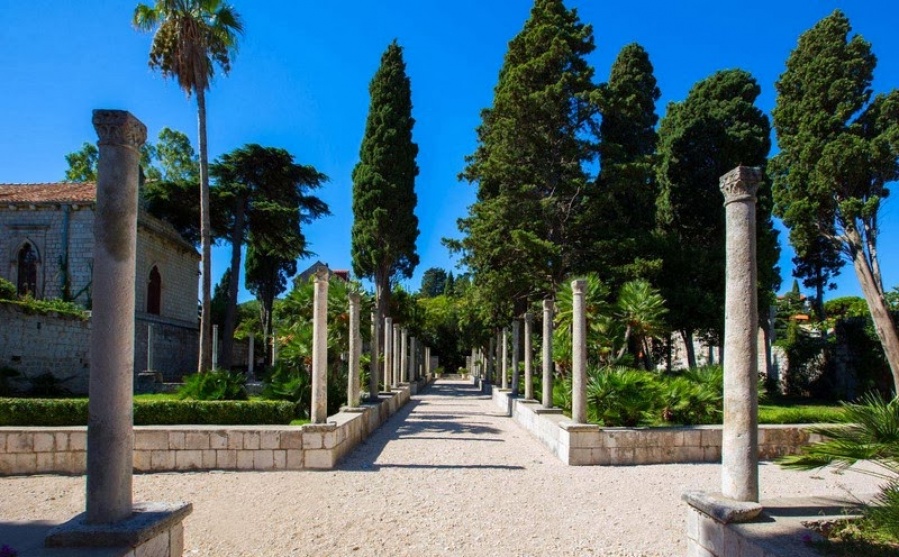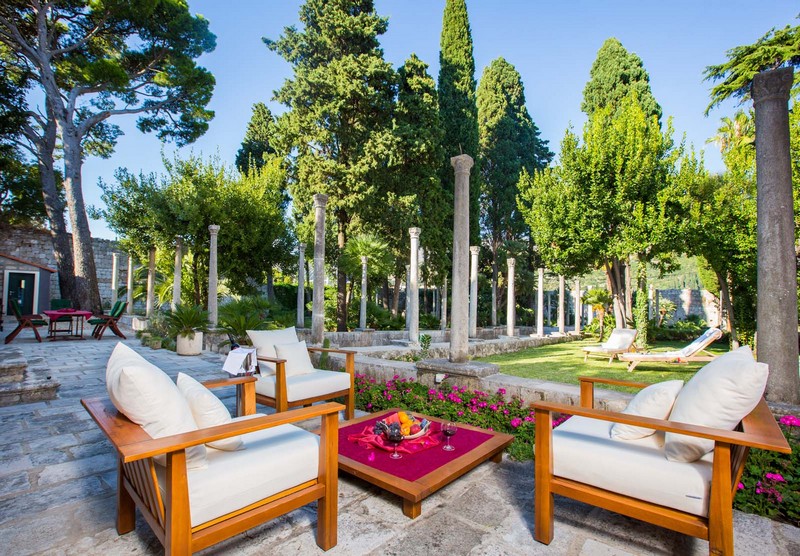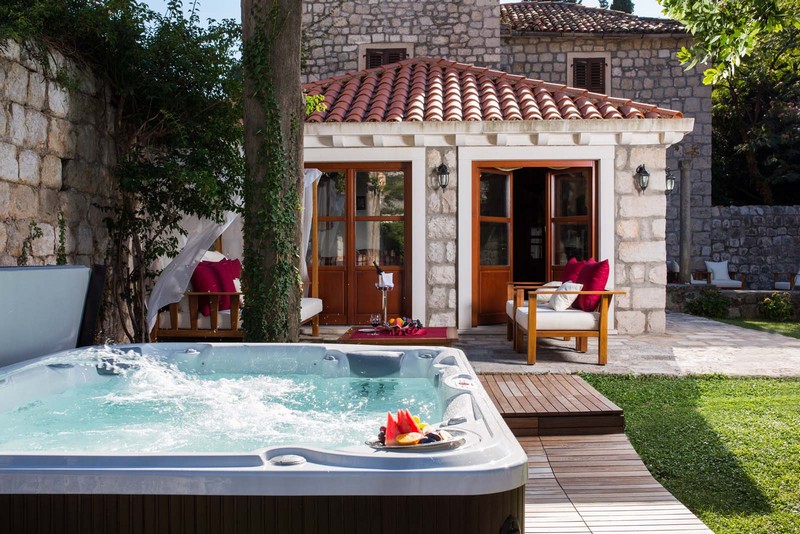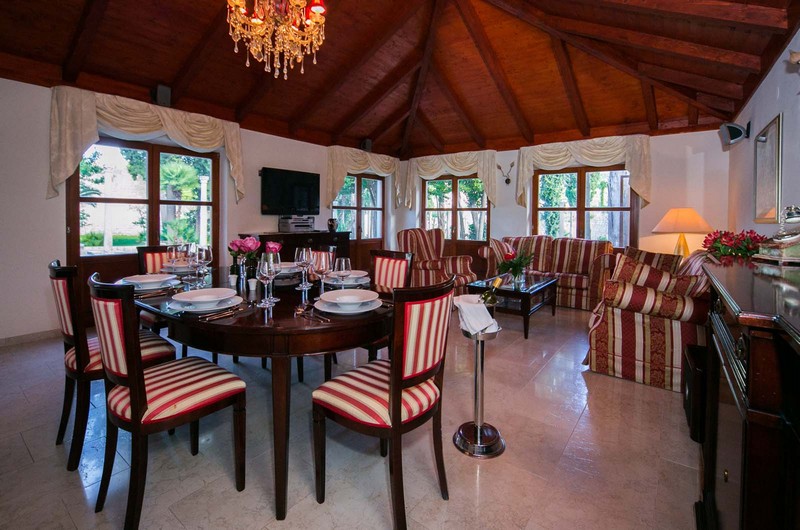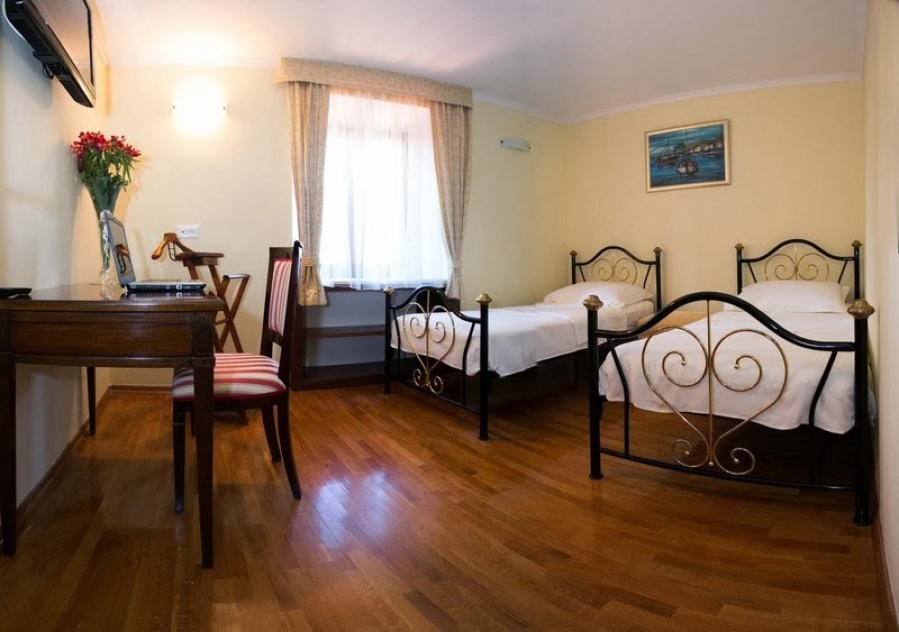Availability
We are sorry, this accommodation is not available to book at the moment
Villa Karolina
Villa Karolina is a luxury villa located on the Lapad shoreline, just 10 minutes driving from the historic Old Town of Dubrovnik. With its high level of privacy, this luxury villa is an ideal holiday accommodation for six persons.
This Mediterranean style luxury villa offers a perfect combination of tradition and modern luxury. It is furnished with handmade furniture in classic Dubrovnik tones of bordeaux and beige. The centre of the villa is the spacious sitting room and dining area which offers a beautiful view of the terrace and gardens. The ground floor also contains a fully equipped open plan kitchen, a bathroom with a tub and a separate toilet.
On the first floor there are two beautiful double bedrooms, while the second floor comprises the most beautiful bedroom with a view of the garden and sea and a luxurious en suite bathroom with shower and tub, which likewise offers an extraordinary view of the villa’s gardens.
The interiors are decorated with paintings by renowned Dubrovnik painters. The 50-year-old Danish chandelier, designer figurines and antique telephones give the villa a special charm.
Villa Karolina is unique in the grandeur of its 2000-square-meter Renaissance garden. Surrounded by high stone walls, the garden features a majestic central walking promenade with original stone columns, each topped by a unique capital, carved with a variety of floral motifs from the garden. These graceful columns today bear witness to the importance of
Dubrovnik landscape architecture of the Renaissance period.
Nearby attractions include the Uvala Lapad walking promenade, a marina, several attractive beaches, many small family restaurants, café bars, and a shopping centre. Due to its location at the shoreline it is ideal for embarkation onto small speedboats, excursion trips and yachts for complete and original enjoyment in the Adriatic Sea.
Other information
Minimum stay: 3 nights in the period 01/06 – 31/10
* prices also include a welcome package of water, fresh fruit and local wine
Check in / check out day: Saturday
Sea view
- Villa equipment:
Washing machine, clothes dryer, air conditioning, cable TV, DVD player, Hi-fi, hair dryer, iron, ironing board, baby cot, high chair, safe, security system, computer available, Internet access, alarm clock, outdoor furniture, chaise longue chairs, charcoal grill, beach towels
- Kitchen equipment:
Electric stove, oven, refrigerator, freezer, dishwasher, toaster, microwave oven, blender, coffee maker
- Bedrooms:
Double-bedded rooms: 2
Twin-bedded rooms: 1
- Bathrooms:
Bathrooms with shower unit: 1
Bathrooms with bath tub and shower: 1
Separate WC: 1
Price includes:
Daily rent / electricity / water / daily cleaning / linen /
towels / garden maintenance / Jacuzzi maintenance
Paid cleaning frequency: daily
Towel change frequency: daily or upon request
Linen change frequency: every 3 days or upon request
Tourist tax included in price.
Additional services:
Butler
Cook
Breakfast
Transfers to and from the airport
Luxury yachts and speedboats
Foreign newspapers and magazines
Additional information:
Deposit on arrival (cash) 500€
Check-in time
Check-out time
Children and extra beds
Pets
Facilities
- DVD Player
- Grill
- Innenstadt
- Jacuzzi
- Klimaanlage
- Küche
- Parking
- Pool
- Safe
- Satelliten-TV
- Spülmaschine
- TV
- Waschmaschine
- Wi-Fi
We are sorry, there are no reviews yet for this accommodation.
Dubrovnik
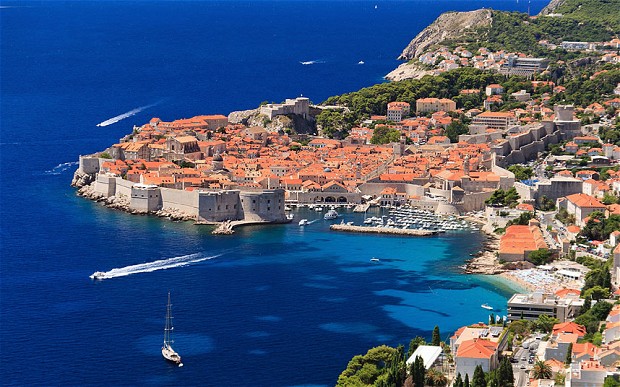
Dubrovnik is located on the thin coast strip between the high hills and the calmness of the Adriatic sea.
The ‘Pearl of the Adriatic’, on the Dalmatian coast, was an important Mediterranean sea power from the 13th century. Dubrovnik was founded in the first half of the 7th century by a group of refugees from Epidaurum, who established their settlement at the island and named it Laus. The Latin name Ragusa (Rausa), in use until the 15th century, originated from the rock (Lat. lausa = rock). Opposite that location, at the foot of Srđ Mountain, the Slavs developed their own settlement under the name of Dubrovnik, derived from the Croatian word dubrava, which means oak woods.
In 1979, the city of Dubrovnik joined the UNESCO list of World Heritage Sites.
Counting only about 35 000 people Dubrovnik is the cultural and social center of the region.
Vegetation in the region is typical, mostly Mediterranean, and it is a result of hundreds of years of human influence. As suited for a merchant harbour city, Dubrovnik mariners traveled far and wide bringing home many tropical and sub-tropical cultures, creating an interesting mixture of plant life.
The name of the most famous street of Dubrovnik is Placa (Stradun) street .
- Dubrovnik is a remarkably well-preserved example of a late-medieval walled city, with a regular street layout. Among the outstanding medieval, Renaissance and Baroque monuments within the magnificent fortifications and the monumental gates to the city are the Town Hall (now the Rector’s Palace), dating from the 11th century; the Franciscan Monastery with its imposing church; the extensive Dominican Monastery; the cathedral (rebuilt after the 1667 earthquake); the customs house (Sponza), the eclectic appearance of which reveals the fact that it is the work of several hands over many years; and a number of other Baroque churches, such as that of St Blaise (patron saint of the city).
The original World Heritage site consisted solely of the defences and the intra-mural city.
It includes the Pile medieval industrial suburb,the Lovrijenac Fortress, located on a cliff,the Lazarets,the Revelin Fortress.
The island of Lokrum lies to the south-east of Dubrovnik, some 500 m from the coast. In 1023 it became a Benedictine abbey.
Dubrovnik is Croatia’s most famous coastal city.
Sports & nature
 The island of Lokrum lies to the south-east of Dubrovnik, some 500 m from the coast. Vegetation in the region is typical, mostly Mediterranean, and it is a result of hundreds of years of human influence.
The island of Lokrum lies to the south-east of Dubrovnik, some 500 m from the coast. Vegetation in the region is typical, mostly Mediterranean, and it is a result of hundreds of years of human influence. Nightlife info
 Night club, music evenings, casino..it is Dubrovnik.
Night club, music evenings, casino..it is Dubrovnik.Culture and history info
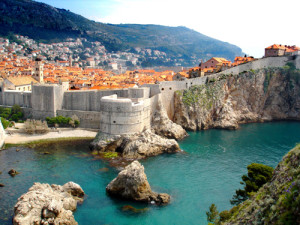 Dubrovnik is a remarkably well-preserved example of a late-medieval walled city, with a regular street layout. Among the outstanding medieval, Renaissance and Baroque monuments within the magnificent fortifications and the monumental gates to the city are the Town Hall (now the Rector's Palace), dating from the 11th century.
Dubrovnik is a remarkably well-preserved example of a late-medieval walled city, with a regular street layout. Among the outstanding medieval, Renaissance and Baroque monuments within the magnificent fortifications and the monumental gates to the city are the Town Hall (now the Rector's Palace), dating from the 11th century. Read more

